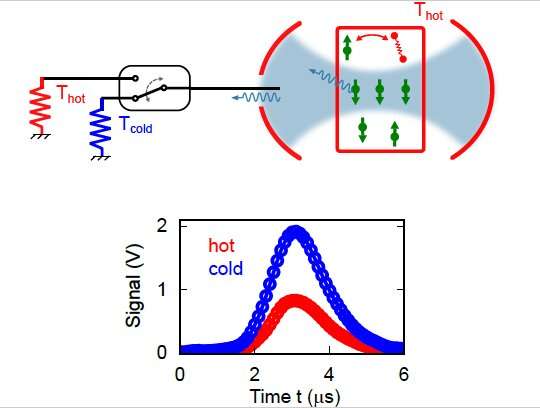May 13, 2020 feature
A new technique for the radiative cooling of spin ensembles

Researchers at CEA/CNRS/Université Paris Saclay, University College London and ETH Zurich have recently devised a new method to control the temperature of a spin ensemble by increasing electron spin polarization above its thermal equilibrium value. Their research, featured in Nature Physics, builds on a study they conducted back in 2016.
In their previous work, the team demonstrated that under certain conditions, the most prominent relaxation channel that allowed electron spins to return to thermal equilibrium was the spontaneous emission of a microwave photon into the resonator they used in their experiments. This phenomenon is known as the Purcell effect.
To reach the Purcell regime, the resonator requires two key characteristics: It should have a small mode volume, and achieve high-quality measurements. These conditions can be met by planar micro-resonators that are made of superconducting materials such as niobium.
"After this previous work, we realized that in the Purcell regime, spins do not only relax faster thanks to the microwave resonator, but that they also thermalize to the temperature set by the microwave field in the resonator instead of the temperature of the crystal in which they are inserted," Patrice Bertet, one of the researchers who carried out the study, told Phys.org. "This new insight led to the idea that the spin temperature is in fact decoupled from the sample, and that one should thus also be able to lower it below the sample temperature simply by cooling down the microwave field inside the resonator."
Cooling spin ensembles can lead to fascinating results, as it increases their polarization, and with it, the signal that can be detected in magnetic resonance experiments. The study carried out by Bertet and his colleagues had two key goals.
Firstly, the researchers wanted to prove that in the Purcell regime, spin temperatures are decoupled from the lattice and fixed solely by the microwave environment. Secondly, they set out to develop a new technique to hyperpolarize a spin ensemble.
"Our second objective was to demonstrate a novel universal way to hyperpolarize an ensemble of electron spins," Bertet said. "This may have numerous interesting applications, since in magnetic resonance, the amount of signal detectable is ultimately limited by the thermal polarization of the ensemble. Therefore, hyperpolarization leads to an enhanced detection signal-to-noise ratio for a given number of spins."
Most of the experiments and data analysis for the study were performed by Bartolo Albanese as part of his Ph.D. thesis at CEA Saclay with the help of all co-authors. In his experiments, Albanese used a silicon crystal with implanted donor spins and a micro-resonator on top of it. The resonator was used both to detect the spin signal and to demonstrate the spin cooling effect.
"In order to lower the microwave field temperature inside the niobium resonator, we simply connected the input of the resonator to a 50ohm resistor cooled at a lower temperature," Bertet explained. "More precisely, we installed the sample containing the spins and the detection resonator at a temperature of 850mK."
Subsequently, Bertet, Albanese and their colleagues coupled the resonator input to a 50ohm resistor cooled at 20mK, using a coaxial cable. If microwave losses are low, this procedure is enough to also cool down the intra-resonator field and in turn the electron spins.
In their recent study, the researchers successfully demonstrated the radiative cooling of a spin ensemble by comparing the spin signal under two different conditions. In the first condition, dubbed hot configuration, the resonator input was coupled to a 50-ohm resistor at the same temperature as the sample. In the second condition, dubbed cold configuration, the resonator was connected to the 50-ohm resistor at 10 mK.
"We observed that the spin signal increased by a factor 2.3 in the cold configuration, proving that spins are radiatively cooled well below the sample temperature," Bertet said. "Moreover, we observed an increase in spin relaxation time in the cold configuration by the same factor, as predicted by theory. Our observations are meaningful both on theoretical and experimental grounds."
From a theoretical perspective, the experiments prove that in the Purcell regime, spins thermalize to a temperature determined by the microwave environment regardless of the sample's temperature. This effect, which had never been observed before, confirms the relevance of the Purcell regime for magnetic resonance applications.
From a more practical standpoint, the radiative cooling technique introduced by the Bertet and his colleagues is the first to enable 'universal' hyperpolarization in electron spins. This method is 'universal' in the sense that it can be applied to all electron spins that can be brought into the Purcell regime.
In the future, the cooling technique devised by the researchers could thus have several practical applications. For instance, it could help to increase the signal-to-noise ratio for electron paramagnetic resonance (EPR) spectroscopy.
"One limitation of the cooling scheme as realized in our experiment is the use of a cold, 50-ohm resistor to cool down the microwave field in the detection resonator, and hence the spins," Bertet said. "This resistor makes it impossible to cool down the spins at a temperature that would be lower than the lowest temperature physically available in the cryostat. Our goal in future studies will be to overcome this limitation, as well as to demonstrate radiative spin cooling at an arbitrarily low temperature by actively cooling the field."
More information: B. Albanese et al. Radiative cooling of a spin ensemble, Nature Physics (2020). DOI: 10.1038/s41567-020-0872-2
A. Bienfait et al. Controlling spin relaxation with a cavity, Nature (2016). DOI: 10.1038/nature16944
Journal information: Nature Physics , Nature
© 2020 Science X Network



















